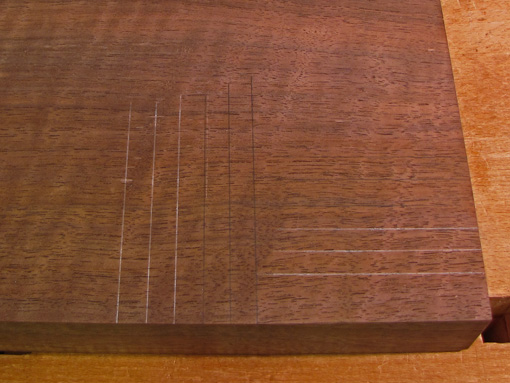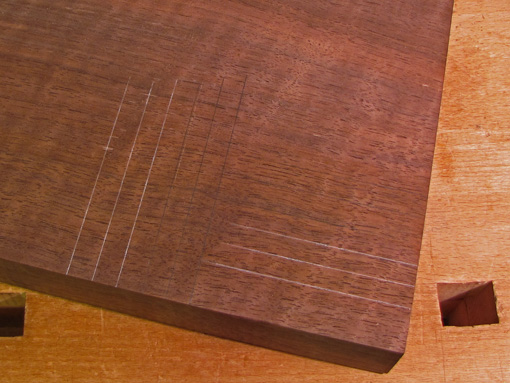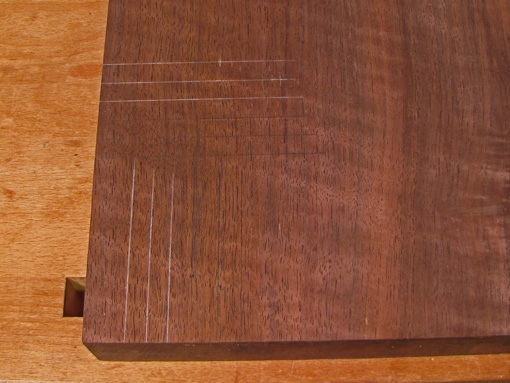
Here is some help with pencil lines on dark wood. Though knife lines can be modified to produce the advantage of a physical feel for the correct location of a tool such as a chisel, most layout in woodworking is done with pencil lines. Marking out the tails for tails-first dovetailing and curved layout lines for bandsawing are examples.
Graphite pencil lines have a bit of sheen which helps their visibility but I still find them difficult to see, particularly if the line is along the grain on a wood like Claro walnut, which is dark and has color variations. So, motivated particularly by my love of Claro, I have experimented with various white or light-colored pencil and ink lines.
I tried Japanese ink “brushes” and very fine point drafting pens. I do not like marking out in ink because I do make mistakes and have no immediate plans to cease, so no ink for me.
I have scoured art supply stores and experimented over the years with various white pencils, occasionally trying bright yellows and other colors. Most are too soft to retain a sharp point for a practical amount of work.
The best pencil I have found is the Sanford/Prismacolor Verithin White #734. It can be sharpened to a point that is nearly as sharp as a #2/HB graphite pencil. It wears faster than a #2 but the point holds up well enough, especially if used with a light touch. It makes a nicely visible line on walnut. It is not as easily erasable as graphite, but decently enough using a white “plastic” eraser. They cost from 39 cents to a dollar apiece, depending on the quantity and the store.
The top photo shows sets of three lines of #2/HB graphite and #734 White going across and along the grain, made from a single sharpening of each pencil. The graphite lines along the grain are barely visible just above the white lines. The photos below show the same lines photographed from different angles.
An alternative is a white 0.5 mm mechanical pencil refill stick made by Pergamano and available from McAllister’s. I have not tried these because they cost $10 for 10 sticks and I would be concerned that they would break easily. Also, the point of the Prismacolor pencil can be easily altered using sandpaper. This is a more fussy job with a less durable result using 0.5mm lead.
No matter what instrument is used for layout, visibility and accuracy are greatly enhanced by using proper lighting. The two simple rules are strong and adjustable. Strong mostly means close, and the light source must be moveable to avoid glare and to cast shadows only in favorable locations. Every effort should be made to set up good lighting.
White #734 sharpened, I’m ready to indulge in Claro.




Hi Rob,
On the topic of lighting, what work lamps (and bulbs and watts) do you use at your workbench? I’m particularly interested in the articulating arm type.
Nice post. Visibility issues in woodworking aren’t covered often enough for me.
Tico
Have you had any luck pouncing chalk into knifed lines? It has worked for me when sawing dovetails in walnut. FWIW.
Tico,
In addition to ceiling light, I have two flourescent units at different heights on the wall in front of my bench, and a three-unit track above the flourescents. I turn on different ones depending on the work. I have one articulating-arm lamp with a large magnifier lens that can be placed in either of two shop-made holders, toward the right and left ends of the bench. The holders are bubinga blocks set into the back of the tool well which house bronze bushings that hold the stem of the lamp.
I think it is critical to be able to move the lamp to change the angle of the light and the distance of the source from the work. The lamp has a 60W daylight spectrum bulb, but that is a minor factor.
My article on workbench upgrades in the November 2007 Popular Woodworking includes the lamp holders, and my article on vision in the shop in the February 2010 PW includes general tips on lighting.
Sean,
Yea, that’s worked as long as I used it sparingly. I find knife lines on the end grain of some woods, like oak, are tough to see.
Thanks for the comments and thanks for reading,
Rob
Just wanted to say hi. Very interesting post.
Jeff
Interesting Idea. I have found pencil marks sometimes are difficult to remove from open pored woods. The graphite gets in the pores so I prefer to use a sharp layout knife. How easy is it to remove the lighter color pencil marks?
Mark,
Sometimes a pencil line is best, such as laying out curves for bandsawing. The white pencil line has to be scrubbed with a big eraser vigorously across the grain. Even then, there will still be some light remnants in some places, but these don’t cause confusion with a new line, which is all that matters.
Rob
I have two tried-and-true methods.
White chalk (for the chalk board) works beautifully for rough layout marks (or notes/labels), sands out instantly, or can be wiped off with a damp paper towel or licked finger. In a pinch a razor knife can put a sharp point on a stick of it.
For fine lines I use a Prismatic Silver pencil that shows up on any medium to dark color and shines if seen at the right angle of lighting. It keeps a nice point, as well.
When working with lighter colored materials I use a #4 Extra Hard Dixon Ticonderoga – the best point possible and a very light stroke will leave a mark that can be seen easily, but doesn’t work into the grain (easy to sand out).
Regards,
Herb.
Try 0.9mm mechanical pencils. It’s thick enough so it practically never breaks. A brief rubbing on sandpaper makes a chiseled end for fine lines. White 0.9mm lead is also available.
Alex,
Thanks, another good idea.
I have a 0.9mm pencil and use it occasionally with H or 2H regular lead, sharpening just as you suggest. I find the chisel edge just doesn’t last long enough with HB lead. I wonder how the white lead would hold up. Several sources showed up with a Google search so I may give it a try.
Thanks for reading and for the contribution.
Rob
Do you know where to get these Sanford/Prismacolor Verithin White #734 pencils. I went to the site for .39 cents but the shipping is outrageous.
Ronnie,
They’re widely available, so you should be able to find them at any well-stocked art supply store in your area, or try a Google search.
Rob